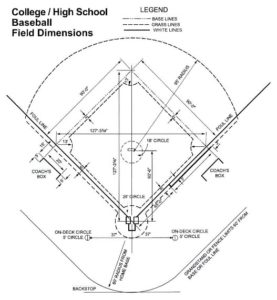How To Layout Your Next Outfield Fence
There are hundreds of youth and community organizations each year who wish to install their own ballfield fencing. When pencil hits paper to start laying-out their field dimensions, inevitably they begin to scratch their heads. How do we get a greater distance from center field to home plate then from right or left field to home plate? Great question!
Looking at your layout, draw a line from the back of home plate through the pitcher’s mound to second base. This line represents the tangent from which the outfield circumference is drawn with the radius point located anywhere along this line. There is no standard or common starting point along this line. The only standard is the distance you are trying to achieve from home plate along the outfield circumference. All fields are designed in consideration of the age group and experience level that the field was designed to accommodate. See below for a quick reference guide for common youth leagues.
Pinto Baseball Field Dimensions
- Foul lines — 125 feet to fence
- Center field fence — 175 feet
- Little League Baseball Field Dimensions
- Foul lines — 200 feet minimum to outfield fence
- Center field fence — 275 feet
- Bronco Baseball Field Dimensions
- Foul lines — 225 feet to outfield fence
- Center field fence— 275 feet
- Pony Baseball Field Dimensions
- Foul lines — 265 feet to outfield fence
- Center field fence— 275 feet
- High School, College, and Pro Baseball Field Dimensions
- Foul lines — 325 feet minimum to outfield fence
- Center field fence— 400-plus feet
- Bottom line, baseball is truly a game of inches and feet measured more often than not by the location of the fence. Be diligent in your installation.
- Foul poles placement require precision down to the inch. Don’t simply eye-ball the poles off the third base line. If this pole is even an inch out of alignment, it may cause some controversial moments during the game. It may need to be relocated to assure no unnecessary foul balls as the stakes begin to rise. It is recommended that a surveyor be employed to properly layout your outfield fencing.
- Beyond the foul poles there is a stretch of fence that connects to the side line fences. This fence may be either a straight line, tangent, to the circumference of the outfield fence or it may be a continuation of the circumference of the outfield fence that connects to the side line fences. There is no standard here.
- Foul poles placement require precision down to the inch. Don’t simply eye-ball the poles off the third base line. If this pole is even an inch out of alignment, it may cause some controversial moments during the game. It may need to be relocated to assure no unnecessary foul balls as the stakes begin to rise. It is recommended that a surveyor be employed to properly layout your outfield fencing.

Bottom line, baseball is truly a game of inches and feet measured more often than not by the location of the fence. Be diligent in your installation.